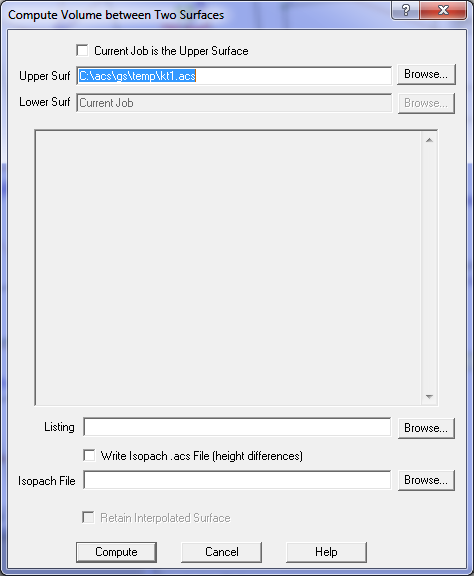Contents
Index
Volume Between Two Surfaces
The program will compute the volume between two surfaces.
The program uses the currently open job (called 'this job') and another job that you sepcify (called the 'other job').
Each point on 'this' job will be projected onto the 'other job', and vice versa.
The program will use the discons in 'this' job to form the surface and the discons in the 'other' job to form the other surface.
The volume is computed using the triangles formed on both surfaces. As the points from each surface have been projected onto the
other surface this allows the volume of each triangular prism to be calculated.
The volume will be computed using the area where the surfaces overlap.

The program will compute the volume between two surfaces.
The following rules must be observed:
- Check the triangle formation with discons each surface is correct prior to computing volumes.
- Note that discons, boundaries and no triangle areas on both surfaces will be used
The volume for each triangular prism is computed by calculating the area (in the horizontal plane)
of the triangle and multiplying it by the height difference between the two surfaces.
The heights of the apex points on the upper surface are averaged, and the heights on the lower surface
are averaged and the height of the prism is the difference between the two levels.
The volumes for each triangular prism are separated into cuts and fills and summed.
The program does not check that the surfaces intersect at the boundaries, thus if the upper surface does
not meet the lower surface at the edge of the job, the program assumes a 'cliff' from the upper to
the lower surface.
Where the surfaces overlap, the program will compute the three dimensional triangle
intersection and hence the cut and fill for that triangle.
Processing steps:
- Start job containing the 'Other' Surface
- Form triangles and check the shape and coverage of the triangles surface using contours.
- Open the job containing 'this surface'.
- Form triangles and check the shape and coverage of the triangles surface using contours.
- Select option Topo/Compute Volumes between Surfaces
- Select 'other job' and Press Compute
Preparation
- Triangulate Design Model. Delete triangles as necessary and form boundary string.
Modify this Boundary if necessary, remove the Max Tri Length restriction (if not already
blank and re-triangulate. Shade triangles to look for ‘holes’. Contour at 0.1m intervals to
inspect for anomalies and correct. Triangulation must be the last thing done to the
model.
- Extract the Boundary string (Edit>>Copy to clipboard, or ctrl+c) and paste into a new acs
file. Make all its points NULL HEIGHT. Place string & points on a new layer such as
“Vol-Bdy”. Save file.
- Interpolate heights of the Boundary points (Points>>Select by String and
click Interp Ht on Points Properties then Save). Now you should have both models
triangulated to exactly the same volume boundary. Ensure Max Tri Length restriction is
blank.
- Interpolate new points in the NS model where your Boundary string intersects NS
discon strings:
(a) Turn point numbers on,
(b) change the string property of your Boundary to Traverse or Discon and re-triangulate.
(c) In the triangle errors, identify each discon string that is crossed by the Boundary and click Take Me There
to see the string intersection.
(d) Choose the Insert IP – Str...Height button that uses the NS Discon string’s height.
(e) Once all
the crossing string errors have been resolved, return the Boundary string Type to
Boundary
(f) Run final triangulation.
